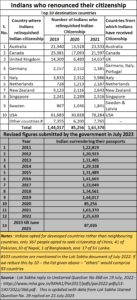Inflated views and deflated economy
RN Bhaskar
“When India moves forward, the world moves forward”
“Today’s India is leaving behind the mentality of slavery and embracing that ancient glory of art.”
Narendra Modi, Prime Minister of India, on 28 May 2023 — https://pib.gov.in/PressReleseDetail.aspx?PRID=1927866
Leaders must inspire their people. That is a must. But leaders must also take care that their claims are not out of sync with realities. India’s grand-eloquence can sometimes become an embarrassment.
Consider the following claims:
- India remains the most favoured destination for investments.
- India will work hard to make the rupee a global currency.
- When India moves forward, the world moves forward.
A closer examination of ground realities highlights several things.
First, India is not the most favoured destination contrary to what Piyush Goyal, Minister for Commerce used to claim. Just look at Japan. India ranks #12 among countries where Japan chooses to invest its money (Free subscription: https://bhaskarr.substack.com/p/the-disintegration-of-governance?sd=pf).
Second, can the rupee become a global currency? Many Indians believe that this is inevitable with de-dollarisation becoming more pronounced. Yes, the dollar is becoming weaker, but the world has not yet abandoned this currency. It will take some more time before (or if) this happens.
If the dollar goes, it is more likely that China’s yuan will step in. The numbers confirm this. China has a higher share of global exports. Moreover, almost 94% of its exports comprise manufactured goods.
Compare the two large countries – USA and China — with India. India enjoys a share of just 1.8% when it comes to exports and 2.5% when it comes to imports. The latest figures show that India’s balance of trade is the worst ever.
It is also worth considering the list of the top five countries from which USA imports and to which it exports. For the US its largest trade partner is Canada followed by exports to Mexico, the EU, China, and Japan. India does not figure here. Nor does India matter when it comes to imports into the US. The countries which matter are China, the EU, Mexico, Canada, and Japan.
Moreover, unlike its next-door neighbour Canada, with whom the US shares the largest trade in the world, India does precious little with its next-door neighbour, China. On the contrary, India does not matter much for China either. For exports, China looks to the US, EU, Hong Kong, Japan, and Korea. As for imports China looks to the EU, Taiwan, Korea, Japan and the US.
With little trade heft, and even less relevance, it does not make sense for India to keep claiming that its rupee will global. Countries hold on to a currency if they have need for it. But if countries depend heavily for neither exports nor imports, why should it hold on to that nation’s currency? This simple fact appears to have escaped the minds and utterances of many politicians. Common folk can be forgiven for believing such absurd possibilities. But surely, not legislators!
If legislators and bureaucrats do not focus on simple realities, they are more likely to lead the entire nation astray. It may sound nice to the galleries. But they can be disastrous when it comes to planning and growth.
this is where another factor becomes relevant – investments.
Study the total stock of investment with countries. We have deliberately taken the BRICS countries for comparison. Once again, India’s role is almost insignificant. It accounted for 1.2% of global inward FDI (foreign direct investment) and 0.6% of global outward FDI.
With such numbers, India should be focussing on improving its trade numbers, especially with its neighbours. Fortunately, the external affairs ministry has said that it is working in this direction (https://www.livemint.com/news/world/india-advances-neighbourhood-first-and-act-east-policies-says-s-jaishankar-on-bimstec-mcg-meet-11689750310488.html).
 Employment woes and agriculture
Employment woes and agriculture
Take the next weakness – unemployment. Although some have claimed that India’s unemployment has been high because of the pandemic, there are strong indications that the reasons lie elsewhere.
India’s largest employer is agriculture-related-activities. During the past eight years. India has weakened its farmers. Its temptation to import agri products has ended up benefitting traders, but not farmers. Such imports have only increased farm distress.
Just consider the way India imported pulses (https://asiaconverge.com/2017/05/pulses-and-the-need-to-protect-indian-agriculture/). Then look at the manner it chose to import edible oil – repeatedly (https://asiaconverge.com/2022/01/the-government-lets-down-indias-edible-oil-industry/), Further, just imagine the consequences for India if the rash proposal by the commerce ministry had sailed through. The ministry under Piyush Goyal wanted to allow milk and milk product imports from New Zealand (https://asiaconverge.com/2019/08/indian-bureaucrats-almost-shortsold-the-milk-industry-at-fta-cpec-negotiations/).
Fortunately for India, the hue and cry against such a move was so huge that the government scrapped all such notions. Also look at the measly prices farmers in Uttar Pradesh (UP) get for the milk they produce. UP is a state run by the BJP, which claims it is farmer friendly. But its milk producers get the worst deal. They don’t even enjoy an MSP (minimum support price) for milk that states like Tamil Nadu have introduced (https://asiaconverge.com/2020/02/budget2020-is-it-sensible-to-double-milk-processing-capacity/). The government is actually wrecking the amazing structure that Verghese Kurien created, which allowed the milk industry to grow without government subsidies and become the largest milk producer in the world (https://asiaconverge.com/2023/01/sodhis-resignation-has-dire-warnings-for-agriculture-and-milk/).
Finally take into account the way the government has banned forward trading in a huge number of agri commodities (https://asiaconverge.com/2022/10/the-folly-of-banning-futures-trading-in-commodities/). That prevents farmers from discovering prices and growing crops that would get them better prices. Without such indicators, the farmer is compelled to live on government doles and freebies (https://asiaconverge.com/2022/12/indian_economy-out-damned-spot/). That is not the best recipe for making a farm community self-reliant.
Agricultural distress reduces the purchasing power of half of India’s population. That in turn affects industry offtake. Doles and subsidies from the government to assuage this situation only increases deficits which in turn threatens to drive other sectors to the ground as well. A good example was the manner in which the government wanted the RBI to cough up Rs.2 – 3 trillion from the RBI’s balance sheet in 2018 for pre-election expenditure (https://www.livemint.com/news/india/demand-for-2-3-tn-sparked-rbi-g vt-clash-saysacharya/amp-11693852197905.html). Which could have been one of the factors that led to the resignation of Viral Acharya, deputy governor, RBI (and possibly Urjit Patel as well).
When governance slips, and economic growth falters, people tend to leave the country. That is what happened with High Networth Indians (HNIs). According to Amit Mitra, Advisor to Chief Minister of West Bengal on Finance. “Under Modi Govt 35,000 Indian Entrepreneurs of High Net Worth LEFT India between 2014 and 2020 (https://twitter.com/DrAmitMitra/status/1451056778846740483). According to Henley Private Wealth Management, the exodus on HNI’s continues (https://asiaconverge.com/2023/06/india-stores-gold-overseas/). As many as 7,500 HNIs left India in 2022.
When HNIs decide to leave, they take with them the entrepreneurial skills and capital that are required to create wealth and more jobs. With job creation on the decline, it is not surprising that India has one of the highest unemployment rates compared to the countries in the neighbourhood (https://asiaconverge.com/2023/06/india-stores-gold-overseas/).
When job creation falters, even common folk begin to vote with their feet. And this is what appears to be taking place. Watch how the number of Indian surrendering their passports – not merely going on a study trip on visas – has kept on increasing annually since 2015. The only year when these numbers did not go up was in 2020 possibly because the pandemic actually prevented people from flying out. The first half of this year puts the figure at 87,026. It remains to be seen how many will quit India this year.
Ironically, you have the government railing against this colonial mindset which makes people flock to the West. Yet you have the same government opting to secure its own gold (free subscription — https://bhaskarrn.substack.com/p/earlier-it-was-diamonds-will-it-now?sd=pf)
in foreign lands (especially in the UK). Evidently, the government must have found a deal to justify keeping its gold overseas. Just the way people find leaving the country a very meaningful option.
Yet ask a simple question of the rah-rah-ing crowds overseas who see India doing very well – If India is doing wonderfully well, why don’t you come back and work in India? That is when they begin to slink away.
What is frightening is that those who leave India come either from affluent families, or are people who can easily get jobs overseas. India thus loses some of its brightest of people and good workers. That blights the employment sector further. Employers often complain that they cannot get the right skills anymore.
That is why, many believe that India is being “hollowed out” (free subscription — https://bhaskarr.substack.com/p/indias-economy-is-being-hollowed?sd=pf). More of this hollowing out in another article.
Education crisis
Given the pathetic state of primary and secondary education in India (free subscription — https://bhaskarr.substack.com/p/the-state-of-education-in-india) and the fact that the brightest choose to leave the country, India is at a critical stage. It can go down the chest-thumping-route and implode. When there is unemployment in conjunction with weakening institutions and poor education, the possibility of rent-a-crowd mobs running amok rapidly becomes a probability. Fuelling them with half crazed stories about religion, or language or even plain hatred against other castes creeds and beliefs becomes very easy.
India must guard itself against such possibilities.
The safest way is not to believe in hyped up and vainglorious stories that have little semblance to reality. India needs to pay sober heed to basic numbers, not hide them under the carpet. The delay in the Census is a grave warning sign. (free subscription — https://bhaskarr.substack.com/p/eas-sarma-asks-home-ministry-not?sd=pf). Other signs could follow soon.









































COMMENTS